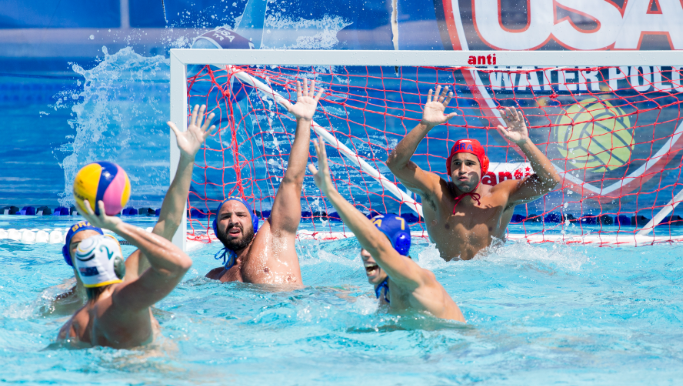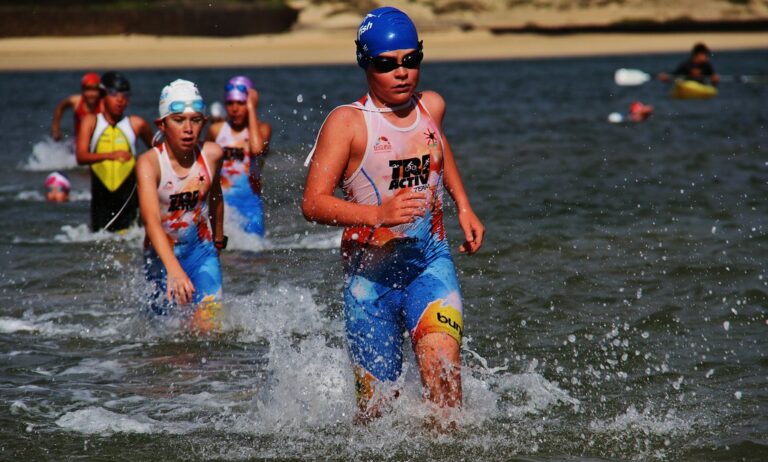General Rules of Water Volleyball
Are you ready to dive into the fun and excitement of water volleyball?
In this article, we’ll cover the general rules that will help you get started and enjoy the game to the fullest. From setting up the court to understanding the scoring system, we’ve got you covered.
Whether you’re a seasoned player or a beginner, these rules will ensure a fair and enjoyable experience for everyone.

So grab your swimsuit and get ready to make a splash in the world of water volleyball
Court Setup
To set up the court for water volleyball, you’ll need a pool or body of water that’s deep enough for players to comfortably play in. The minimum water depth should be at least 3 feet (0.91 meters) to allow for safe play and prevent any injuries. Players should be able to comfortably stand and move around without touching the bottom of the pool.
The net height for water volleyball is usually set at around 7 feet 11 inches (2.41 meters) for men and 7 feet 4 inches (2.24 meters) for women. This ensures that the net is at a height that allows for challenging and competitive gameplay. The net should be securely fastened and positioned in the center of the playing area.
When it comes to court dimensions, the standard size for water volleyball is 30 feet (9.14 meters) in width and 60 feet (18.29 meters) in length. This provides enough space for players to move around and dive for the ball. It’s important to mark the boundaries of the court using floating ropes or buoys to clearly define the playing area.
Number of Players
Make sure you have enough teammates for a competitive game of water volleyball. The number of players in a water volleyball game can vary depending on the level of competition and the available space in the pool. Generally, each team consists of six players, with three players positioned in the front row and three in the back row. This allows for a balanced distribution of players and facilitates effective gameplay.
Playing positions in water volleyball are similar to those in traditional indoor volleyball. The front row players are responsible for blocking and attacking, while the back row players focus on defense and setting. The positions in the front row are called the outside hitter, middle blocker, and opposite hitter, while the positions in the back row are the setter, libero, and back-row outside hitter.
Team formations in water volleyball can vary depending on the strategy and the skills of the players. The most common formation is the 5-1, where there’s one designated setter who stays in the back row and sets the ball for the attackers. Another popular formation is the 6-2, where both setters rotate as hitters, allowing for more offensive options.
It is important to note that water volleyball is a versatile sport, and teams can adapt their formations based on their strengths and the tactics they wish to employ. Some teams may opt for a more defensive approach, while others may focus on a strong offense. Ultimately, the number of players and the formations used in water volleyball should be chosen to maximize teamwork and competitive play.
Game Duration
You typically play water volleyball games for a set amount of time to ensure fairness and equal opportunities for both teams. The duration of a water volleyball game can vary depending on factors such as the level of competition and the number of teams participating. However, in most cases, a standard game is played to a certain number of points or a specific time limit.
Here are some key points to consider regarding game duration in water volleyball:
-
Strategic planning: The duration of the game allows teams to strategize and implement their game plan effectively. With a set amount of time, teams can develop strategies to score points and win the game.
-
Importance of teamwork: Water volleyball is a team sport that requires coordination and cooperation among team members. The game duration provides opportunities for teams to practice and improve their teamwork skills, such as communication, trust, and support.
-
Time management: Playing a game for a specific duration encourages teams to manage their time wisely. It teaches players to make quick decisions, prioritize their actions, and adapt to changing circumstances within the allotted time.
-
Fairness and equal opportunities: By having a predetermined game duration, both teams have an equal chance to showcase their skills and compete on an even playing field. It ensures that neither team gains an unfair advantage due to longer or shorter game durations.
-
Sense of urgency: A set game duration adds excitement and intensity to the game. Players are motivated to give their best and make every second count as they strive to achieve victory within the given time frame.
Serve and Serve Receive
How can you effectively execute and receive serves in water volleyball?
Serving and serve receive are crucial aspects of the game that can greatly impact the outcome of a match. To effectively execute a serve, serve placement and tactics play a significant role.
Serve placement is key in water volleyball. By strategically placing your serve, you can put pressure on the opposing team and increase your chances of scoring. Aim for spots on the court where it’s difficult for the receiver to reach, such as the corners or close to the net. By varying your serve placement, you can keep the opposing team guessing and make it harder for them to anticipate your serves.
Serve tactics are also essential in water volleyball. By using different types of serves, you can keep the opposing team off balance and gain an advantage. Some common serve tactics include the float serve, where the ball moves unpredictably in the air, and the topspin serve, which has a downward trajectory and can be difficult to handle. Experiment with different serve tactics to find what works best for you and your team.
On the other hand, receiving serves is just as crucial. By effectively receiving serves, you can set up your team for a successful attack. Focus on maintaining a good body position and being ready to react quickly. Anticipate where the server is likely to place their serve and position yourself accordingly. By communicating with your teammates and adopting a coordinated approach, you can improve your serve receive and increase the chances of a successful attack.
Scoring System
The scoring system in water volleyball is straightforward and easy to understand. Here are some scoring techniques and strategies for winning:
-
Point-based system: Each team can score a point when they successfully serve or return the ball over the net and it lands within the opponent’s court. The team that reaches a predetermined number of points first wins the game.
-
Ace: A player serves the ball in a way that the opponent fails to make a valid return, resulting in an immediate point for the serving team. Aces can be a powerful scoring technique and can help gain an advantage in the game.
-
Block: When a player jumps and intercepts an opponent’s attack, causing the ball to land within the opponent’s court, it results in a point for the blocking team. Effective blocking can be a strategic scoring technique to disrupt the opponent’s offense.
-
Kill: A kill happens when a player spikes the ball in a way that it lands within the opponent’s court and the opposing team fails to make a valid return. Kills are aggressive scoring techniques that require precision and power.
-
Sideout: If the receiving team successfully defends against the opponent’s attack and regains the serve, it’s called a sideout. Sideouts are important for maintaining or gaining the lead in the game.
To increase your chances of winning, it’s crucial to understand these scoring techniques and incorporate them into your strategy. Aim for aces, execute well-timed blocks, and go for powerful kills to score points. Additionally, focus on defending against the opponent’s attacks to regain the serve through sideouts.
Rules for Ball Handling
When it comes to ball handling in water volleyball, there are specific rules to keep in mind.
Firstly, players aren’t allowed to dribble or throw the ball. Instead, they must use clean hits to pass the ball to their teammates.
Additionally, double touches are allowed, meaning that a player can hit the ball twice in a row as long as it’s done in one motion.
Dribbling or Throwing
You should only dribble or throw the ball once before passing it to another player.
Dribbling in water volleyball has several benefits that can enhance your gameplay. It allows you to maintain better control of the ball, giving you more time to strategize your next move. Dribbling also helps improve your hand-eye coordination and strengthens your arm muscles.
When it comes to throwing the ball, there are a few techniques you can use to ensure effectiveness. Firstly, make sure to position your body correctly and use your legs to generate power. Secondly, focus on your aim and try to throw the ball with accuracy. Lastly, practice different throwing techniques such as overhand, sidearm, and underhand to increase your versatility on the court.
Double Touches Allowed?
Are double touches allowed during ball handling in water volleyball?
No, double touches aren’t allowed in water volleyball. In water volleyball, each player is only allowed to touch the ball once during a single play. This rule is in place to ensure fair play and maintain the integrity of the game.
Double touches, where a player contacts the ball twice in succession, are considered illegal and result in a fault. If a double touch occurs, the opposing team is awarded a point and the serve.
It’s important for players to practice proper ball handling techniques to avoid double touches. This includes using clean and controlled contact with the ball to maintain a continuous and fluid play.
Blocking and Spiking
Get ready to master the art of blocking and spiking in water volleyball! These two skills can make a huge difference in your performance on the court.
Whether you’re aiming to block your opponent’s shots or spike the ball with power and precision, here are some tips and strategies to help you improve your technique:
-
Timing is everything: When it comes to blocking, timing is crucial. Watch your opponent’s movements and try to anticipate when they’ll hit the ball. Jump up at the right moment to block their shot effectively.
-
Position yourself correctly: Positioning is key for both blocking and spiking. When blocking, make sure your hands are above the net and angled towards the opponent’s side of the court. For spiking, approach the net from an angle and jump off one foot to maximize your power.
-
Use your body: Engage your entire body when blocking and spiking. Use your legs to generate power and your arms to direct the ball. Don’t be afraid to use your body to create momentum and get higher in the air.
-
Communicate with your team: Effective blocking and spiking require good communication with your teammates. Let them know when you’re going to block and when you’re going to spike. Coordinate your movements to create a strong defense and offense.
-
Practice, practice, practice: The more you practice, the better you’ll become at blocking and spiking. Work on your timing, positioning, and technique. Practice with a partner or join a water volleyball team to get more game-like experience.
By following these tips and strategies, you’ll be well on your way to becoming a blocking and spiking expert in water volleyball.
Violations and Penalties
To avoid confusion and maintain fair play, it’s important to be aware of the violations and penalties in water volleyball. Knowing the consequences of violations and implementing strategies to avoid penalties can greatly enhance your team’s performance and overall experience in the game.
One of the most common violations in water volleyball is touching the net. When a player makes contact with the net during the game, it results in a penalty. The consequences of this violation can vary depending on the severity and intent. In some cases, a minor touch may result in a loss of possession, while a more deliberate action can lead to a point deduction or even disqualification. To avoid penalties for touching the net, it’s crucial to maintain proper body positioning and awareness during gameplay. Focus on your movements and be mindful of the net’s location at all times.
Another violation to watch out for is improper rotation. In water volleyball, players must rotate positions in a specific order to maintain fairness and balance. Failing to follow the correct rotation pattern can result in a penalty, such as a loss of possession or point deduction. To avoid penalties for improper rotation, make sure to communicate with your teammates and stay aware of your designated position. Pay attention to the referee’s signals and be ready to switch positions when necessary.
In addition, certain actions, such as using foul language, displaying unsportsmanlike behavior, or intentionally injuring an opponent, can result in severe penalties, including disqualification from the game or even suspension from future matches. It’s essential to maintain respect for the game, your opponents, and the officials to avoid such penalties.
Frequently Asked Questions
Are There Any Specific Clothing Requirements for Playing Water Volleyball?
When playing water volleyball, it’s important to wear suitable clothing that allows you to move freely in the water. There are no specific clothing requirements for this sport, but it’s recommended to wear a swimsuit or other comfortable swimwear that won’t restrict your movements.
You can also consider wearing a rash guard or water shoes for added protection and grip. Ultimately, the goal is to wear attire that allows you to enjoy the game without any hindrance.
Can Players Switch Positions During a Game of Water Volleyball?
Yes, players can switch positions during a game of water volleyball.
Switching positions can be an effective strategy to adapt to the game flow and maximize team performance. It allows players to utilize their skills in different areas of the court and keep the opponents guessing.
Position switching can also enhance team dynamics by promoting teamwork and communication. Players must coordinate their movements and communicate effectively to ensure a smooth transition and maintain a strong defensive and offensive presence.
Is There a Specific Height Requirement for the Net in Water Volleyball?
In water volleyball, the height requirement for the net is an important aspect of the game. The net height determines the level of challenge and fairness for players. It ensures that the ball is at an appropriate height for players to hit over the net.
While there mightn’t be a specific height requirement mentioned in the general rules, it’s usually set at a standard height to maintain consistency and make the game enjoyable for all participants.
Can Players Touch the Net During Gameplay?
During gameplay, you should avoid touching the net in water volleyball. Net interference can result in penalties and consequences for your team.
It’s essential to maintain a fair and level playing field for both teams. Touching the net can disrupt the flow of the game and give your team an unfair advantage.
To ensure a fair and enjoyable match, be mindful of the net and refrain from touching it during gameplay.
Are There Any Restrictions on the Type of Ball Used in Water Volleyball?
In water volleyball, there are no specific restrictions on the type of ball used. However, it’s important to consider different ball sizes and materials.
Depending on the level of play and personal preference, players may choose a larger or smaller ball. Some may opt for a softer ball made of foam or rubber, while others may prefer a harder ball made of plastic or leather.
Ultimately, the choice of ball is up to the players and their individual needs.






